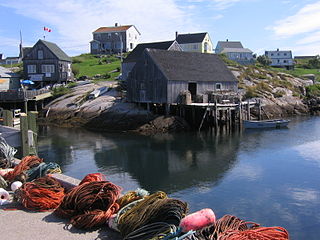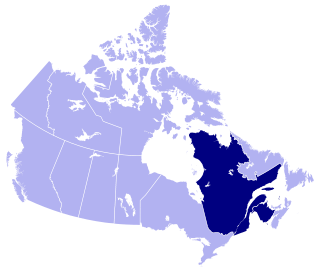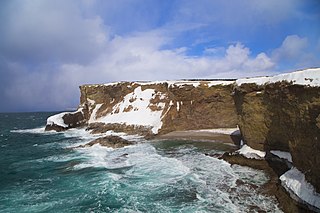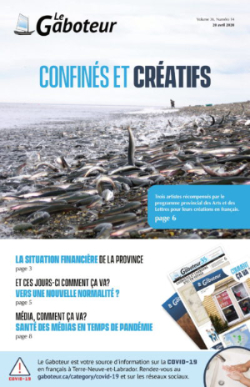
The Maritimes, also called the Maritime provinces, is a region of Eastern Canada consisting of three provinces: New Brunswick, Nova Scotia, and Prince Edward Island. The Maritimes had a population of 1,899,324 in 2021, which makes up 5.1% of Canada's population. Together with Canada's easternmost province, Newfoundland and Labrador, the Maritime provinces make up the region of Atlantic Canada.

The flag of Newfoundland and Labrador was introduced in 1980 and was designed by Newfoundland artist Christopher Pratt. The flag design was approved by the House of Assembly of the province of Newfoundland, Canada, on May 28, 1980. It was flown for the first time on Discovery Day, June 24, 1980. The name of the province was changed to Newfoundland and Labrador by an amendment to the constitution of Canada in December 2001 at the request of the provincial legislature.

French Canadians, or Franco-Canadians, are an ethnic group who trace their ancestry to French colonists who settled in France's colony of Canada beginning in the 17th century.
Newfoundland and Labrador is an Atlantic Canadian province with a folk musical heritage based on the Irish, English and Cornish traditions that were brought to its shores centuries ago. Though similar in its Celtic influence to neighboring Nova Scotia and Prince Edward Island, Newfoundland and Labrador music is more Irish than Scottish and has more elements imported from English and Cornish music than those provinces.

Newfoundland French or Newfoundland Peninsular French, refers to the French spoken on the Port au Port Peninsula of Newfoundland. The francophones of the region can trace their origins to Continental French fishermen who settled in the late 1800s and early 1900s, rather than the Québécois. Some Acadians of the Maritimes also settled in the area. For this reason, Newfoundland French is most closely related to the Norman and Breton French of nearby St-Pierre-et-Miquelon. Today, heavy contact with Acadian French—and especially widespread bilingualism with Newfoundland English—have taken their toll, and the community is in decline.

French is the mother tongue of approximately 7.2 million Canadians according to the 2016 Canadian Census. Most Canadian native speakers of French live in Quebec, the only province where French is the majority language and the only province in which it is the sole official language. Of Quebec's people, 71.2 percent are native francophones and 95 percent speak French as their first or second language.
CBAFT-DT is an Ici Radio-Canada Télé station in Moncton, New Brunswick, Canada, serving Acadians in the Maritimes and Franco-Newfoundlanders in Newfoundland and Labrador. It is part of a twinstick with Fredericton-based CBC Television station CBAT-DT. CBAFT-DT's studios are located on Main Street in Moncton, adjacent to the Dieppe border and the CF Champlain shopping centre, and its transmitter is located on Timberline Road in Moncton.

The Port au Port Peninsula is a peninsula in the Canadian province of Newfoundland and Labrador. Roughly triangular in shape, it is located on the west coast of the island of Newfoundland.
The history of Saint Pierre and Miquelon is one of early settlement by Europeans taking advantage of the rich fishing grounds near Saint-Pierre and Miquelon, and is characterized by periods of conflict between the French and British.

Atlantic Canadian English is a class of Canadian English dialects spoken in Atlantic Canada that is notably distinct from Standard Canadian English. It is composed of Maritime English and Newfoundland English. It was mostly influenced by British and Irish English, Irish and Scottish Gaelic, and some Acadian French. Atlantic Canada is the easternmost region of Canada, comprising four provinces located on the Atlantic coast: Newfoundland and Labrador, plus the three Maritime provinces of Nova Scotia, New Brunswick, and Prince Edward Island. Regions such as Miramichi and Cape Breton have a wide variety of phrases and words not spoken outside of their respective regions.

CJRM-FM is a Canadian radio station, broadcasting at 97.3 FM in Labrador City. It is a francophone community radio station branded as Rafale FM. Although still a licensed station, it has not broadcast regularly since 2015, due to a combination of technical and staffing problems.
Canadian French is the French language as it is spoken in Canada. It includes multiple varieties, the most prominent of which is Québécois. Formerly Canadian French referred solely to Quebec French and the closely related varieties of Ontario (Franco-Ontarian) and Western Canada—in contrast with Acadian French, which is spoken by Acadians in New Brunswick and some areas of Nova Scotia, Prince Edward Island and Newfoundland & Labrador.
Mainland is a local service district and designated place in the Canadian province of Newfoundland and Labrador. It is on the western shore of the Port au Port Peninsula approximately 50 kilometres (31 mi) from the Stephenville International Airport. Mainland is a coastal community, bordered by both the ocean and forest. The main industry in the community has traditionally been fishing, but currently (2016) a large portion of the inhabitants leave the community seasonally to earn income.

Newfoundland is a large island situated off the eastern coast of the North American mainland and the most populous part of the Canadian province of Newfoundland and Labrador. The island contains 29 percent of the province's land area. The island is separated from the Labrador Peninsula by the Strait of Belle Isle and from Cape Breton Island by the Cabot Strait. It blocks the mouth of the Saint Lawrence River, creating the Gulf of Saint Lawrence, the world's largest estuary. Newfoundland's nearest neighbour is the French overseas collectivity of Saint Pierre and Miquelon.
Émile Joseph Benoît was a Canadian fiddler who became known for popularizing Franco-Newfoundlander folk music traditions.

The Newfoundland expedition was a series of fleet manoeuvres and amphibious landings in the coasts of Newfoundland, Labrador and Saint Pierre and Miquelon carried out by the combined French and Spanish fleets during the French Revolutionary Wars. This expedition, composed of seven ships of the line and three frigates under the orders of Rear-Admiral Richery sailed from Cadiz in August 1796 accompanied by a much stronger Spanish squadron, commanded by General Solano, which had the aim of escorting it to the coast of Newfoundland.

Le Gaboteur is a Canadian newspaper, published in St. John's, Newfoundland and Labrador. The province's only French language newspaper, the publication serves the Franco-Newfoundlander community as well as the nearby French territory of St. Pierre and Miquelon.
Françoise Enguehard a French-speaking author from Saint-Pierre-et-Miquelon who now resides in Canada. She served as president of the National Society of Acadia from 2006 to 2012 and is the current president of the National Acadian Foundation. She and her husband have been involved in promoting the history and education about Acadian people, through the development of schools. She speaks throughout the French-speaking countries to promote French culture. She received the rank of Knight in the Order of La Pléiade in 2011 and was honored as a knight in the Legion of Honour, France's highest award, in 2015 for her commitment to preserving the heritage of Acadians and Saint-Pierre-et-Miquelon.

The settlement of Basques in the Americas was the process of Basque emigration and settlement in the New World. Thus, there is a deep cultural and social Basque heritage in some places in the Americas, the most famous of which being Saint Pierre and Miquelon, Central America, Guatemala and Antioquia, Colombia.

Terre-Neuve ("Newfoundland") was a colony in New France that existed from 1655 to 1713, and which consisted of the southern portion of Newfoundland island. The most -and sometimes only- populated region was Placentia, called "Plaisance" in French. Because of Placentia's geographic position, its main economic activity was fishing, and the settlement could serve as a pit stop for ships traveling to and from France and other New France colonies like Canada or Acadia. Terre-Neuve ceased to exist in 1713, when France evacuated its settlers and transplanted them to Cape Breton. But, France regained the Saint Pierre and Miquelon islands of this colony in 1763, and still has possession over them today.













